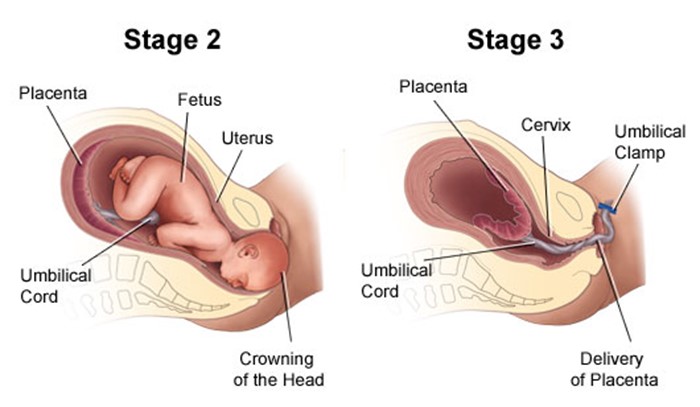What nursing intervention is particularly indicated for the second stage of labor?
Providing pain medication to increase the client's tolerance of labor pains
Assessing the fetal heart rate and pattern for signs of fetal distress
Assisting the client to push effectively so that expulsion of the fetus can be achieved
Monitoring effects of oxytocin administration to help achieve cervical dilation
The Correct Answer is C
Choice A reason: Providing pain medication to increase the client's tolerance of labor pains is not a specific intervention for the second stage of labor. Pain medication is a drug that relieves pain by blocking pain signals or reducing inflammation. Pain medication can be given during any stage of labor, depending on the client's preference and condition. However, pain medication may have side effects such as sedation, nausea, or respiratory depression, and may affect the fetal heart rate or the progress of labor.
Choice B reason: Assessing the fetal heart rate and pattern for signs of fetal distress is not a particular intervention for the second stage of labor. Fetal heart rate and pattern are indicators of fetal well-being and oxygenation. Fetal heart rate and pattern should be monitored throughout labor, especially during contractions, to detect any abnormalities or complications such as bradycardia, tachycardia, or decelerations.
Choice D reason: Monitoring effects of oxytocin administration to help achieve cervical dilation is not a relevant intervention for the second stage of labor. Oxytocin is a hormone that stimulates uterine contractions and cervical dilation. Oxytocin can be administered during labor to augment or induce labor, especially if there is prolonged or dysfunctional labor. However, oxytocin is not needed in the second stage of labor, when the cervix is already fully dilated and the focus is on pushing and delivering the baby.

Nursing Test Bank
Naxlex Comprehensive Predictor Exams
Related Questions
Correct Answer is C
Explanation
Choice C is correct because repositioning the infant every 2 hours can help expose different parts of the skin to the phototherapy light and increase the effectiveness of the treatment. The nurse should also check the skin for signs of irritation or burns.
Choice A is incorrect because feeding the infant every 4 hours is not specific to home phototherapy. The infant may need more frequent feedings depending on their hunger cues and weight gain.
Choice B is incorrect because performing diaper changes under the light is not necessary and may expose the infant's genitals to excessive light and heat. The nurse should advise the parents to cover the infant's eyes and genitals with protective shields during phototherapy.
Choice D is incorrect because covering the infant with a receiving blanket can reduce the exposure of the skin to the phototherapy light and decrease the effectiveness of the treatment. The nurse should advise the parents to keep the infant unclothed or only in a diaper during phototherapy.
Correct Answer is B,A,C,D
Explanation
The correct order is:
- Note date and time of the behavior.
- Discuss the issue privately with the UAP.
- Plan for scheduled break times.
- Evaluate the UAP for signs of improvement.
Here are the reasons for this order:
- Note date and time of the behavior. This should be done first, as it can provide objective evidence of the UAP's behavior and its impact on patient care and staff workload. The unit manager should document any incidents or complaints related to the UAP's behavior in a factual manner.
- Discuss the issue privately with the UAP. This should be done second, as it can provide an opportunity for feedback and clarification. The unit manager should use a respectful and professional tone, and explain how the UAP's behavior affects patient safety and staff morale. The unit manager should also listen to any concerns or challenges that the UAP may have, and offer support or guidance as needed.
- Plan for scheduled break times. This should be done third, as it can provide a solution or prevention strategy for future occurrences. The unit manager should work with the UAP and other staff members to ensure that there are adequate breaks and coverage for patient care. The unit manager should also review any policies or procedures related to break times and staff attendance.
- Evaluate the UAP for signs of improvement. This should be done last, as it can provide a measure of effectiveness and accountability. The unit manager should monitor and document any changes in the UAP's behavior, performance, or attitude. The unit manager should also provide positive reinforcement or corrective action as appropriate.
Whether you are a student looking to ace your exams or a practicing nurse seeking to enhance your expertise , our nursing education contents will empower you with the confidence and competence to make a difference in the lives of patients and become a respected leader in the healthcare field.
Visit Naxlex, invest in your future and unlock endless possibilities with our unparalleled nursing education contents today
Report Wrong Answer on the Current Question
Do you disagree with the answer? If yes, what is your expected answer? Explain.
Kindly be descriptive with the issue you are facing.
